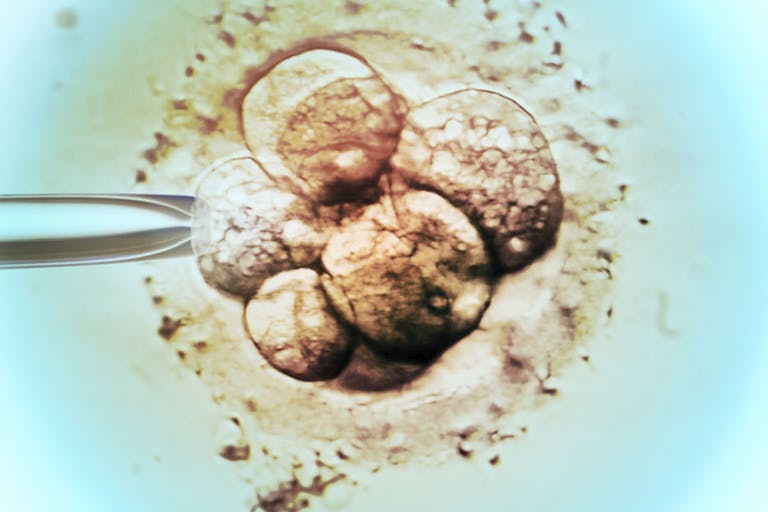
Texas library can keep sexually explicit material from minors... for now
Sheena Rodriguez
·
Scientists capture footage of human embryo implantation… but at what cost?
New “groundbreaking” footage shows human embryo implantation in real time, using ‘leftover’ embryos that were donated to research. But regardless of how groundbreaking this footage may be, the embryos involved were human beings who were implanted into a fake uterus — and then discarded once they served their “purpose.”
The Institute for Bioengineering of Catalonia released “groundbreaking footage” of human embryos implanting in a fake uterus.
The Dexeus University Hospital in Barcelona donated the embryos.
The experiment was allegedly carried out to find ways to combat infertility.
The embryos were portrayed as invaders, with researchers claiming that they “burrow into the uterus, exerting considerable force during the process.”
After the experiment, the embryos are believed to have been discarded.
Scientists seeking to understand human implantation in the womb have taken the first step in doing so — and intentionally destroyed human lives in the process.
Researchers at the Institute for Bioengineering of Catalonia (IBEC) collaborated with Dexeus University Hospital in Barcelona, which donated leftover embryos to the experiment. Unable to study in vivo human embryos, the scientists set out to create an ex vivo environment in which the embryos could develop.
Using collagen and uterine tissue, they built an imitation uterus, inserted the embryos, and watched them implant using fluorescence imaging and real-time analysis of an embryo’s interactions with its environment.
“To study the mechanical interaction of the embryo with its surroundings, we designed two complementary platform configurations,” researchers wrote. “In the first one, blastocysts were let to settle on top of a 2D flat gel where, eventually, they bound to the collagen surface. In the second one, blastocysts were placed inside collagen drops close to the glass surface, where they become integrated in the matrix. The two setups allow to mimic the different states of early embryo implantation where the blastocyst encounters first a surface (2D platform) before either penetration of the stromal layer or by being engulfed by the surrounding tissue (3D platform) and thereafter transitioning to the peri-implantation embryo.”
Amélie Godeau, researcher and co-first author of the study, explained, “We observe that the embryo pulls on the uterine matrix, moving and reorganising it. It also reacts to external force cues. We hypothesise that contractions occurring in vivo may influence embryo implantation.”
Samuel Ojosnegros, lead author of the study, said the experiment reveals how the implantation process happens.
“We have observed that human embryos burrow into the uterus, exerting considerable force during the process,” Ojosnegros said. “These forces are necessary because the embryos must be able to invade the uterine tissue, becoming completely integrated with it. It is a surprisingly invasive process. Although it is known that many women experience abdominal pain and slight bleeding during implantation, the process itself had never been observed before” (emphases added).
This language vilifies embryos, making them appear as “invaders,” rather than as innocent humans created by two adult human beings in a deliberate act — in this case, IVF.
Article continues below
Dear Reader,
Have you ever wanted to share the miracle of human development with little ones? Live Action is proud to present the "Baby Olivia" board book, which presents the content of Live Action's "Baby Olivia" fetal development video in a fun, new format. It's perfect for helping little minds understand the complex and beautiful process of human development in the womb.
Receive our brand new Baby Olivia board book when you give a one-time gift of $30 or more (or begin a new monthly gift of $15 or more).
The implantation process is the natural result of procreative sex, not an invasion by a foreign, uninvited entity.
We don’t have to turn our gaze too far back in time to see examples of such dehumanization and villainization, which are now shameful pieces of mankind’s past.
Yet because embryos look different from more developed human beings, are vulnerable, and are dependent on older humans for survival, medical experiments are carried out on them. Then, they are left for dead or actively killed when their scientific usefulness has expired.
This is what happened to the embryos in this research. They were donated by a hospital — likely leftover from IVF treatments paid for by adults desperate for a child, who soon found themselves with more children than they wanted. They were marked for experimentation — and, therefore, premature death — and their brief lives were filmed, studied, and commented on before they were ultimately destroyed.
These were little performers who were denied their rights, and for what?
Researchers claim the study will help better combat infertility because failure during the implantation process is a main cause of infertility. But all this means is that researchers experimented on embryos who were deemed “unwanted” in order to find ways to support future “wanted” embryos.
History shows that experiments such as this are ethical disasters.
Follow Live Action News on Facebook and Instagram for more pro-life news.
Live Action News is pro-life news and commentary from a pro-life perspective.
Contact editor@liveaction.org for questions, corrections, or if you are seeking permission to reprint any Live Action News content.
Guest Articles: To submit a guest article to Live Action News, email editor@liveaction.org with an attached Word document of 800-1000 words. Please also attach any photos relevant to your submission if applicable. If your submission is accepted for publication, you will be notified within three weeks. Guest articles are not compensated (see our Open License Agreement). Thank you for your interest in Live Action News!

Sheena Rodriguez
·
Issues
Sheena Rodriguez
·
Guest Column
Right to Life UK
·
Issues
Bridget Sielicki
·
International
Cassy Cooke
·
Issues
Sheena Rodriguez
·
Human Interest
Nancy Flanders
·
Investigative
Nancy Flanders
·
Pop Culture
Nancy Flanders
·
Human Interest
Nancy Flanders
·
Human Interest
Nancy Flanders
·